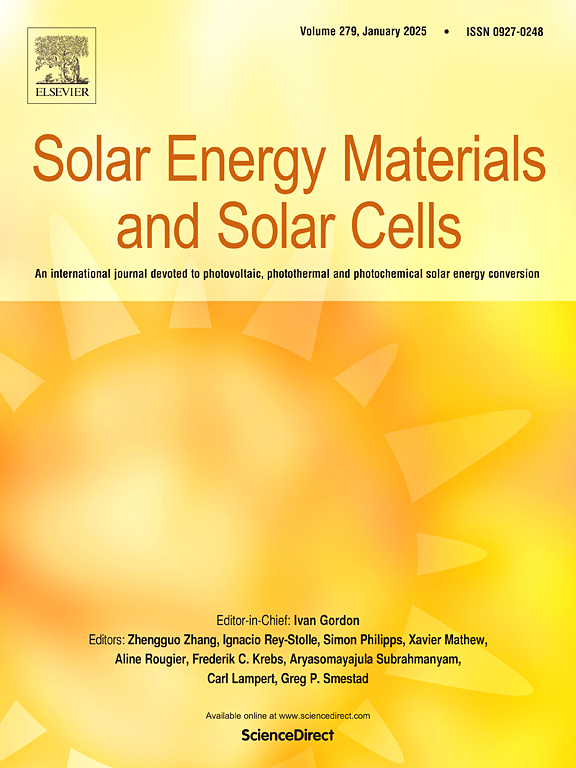IF 6.3
2区 材料科学
Q2 ENERGY & FUELS
引用次数: 0
摘要
多晶硅(Poly-Si)钝化触点是实现硅理论效率极限(29.4%)的关键技术之一。然而,硅表面钝化在金属化过程中的降解仍然是一个问题,这就需要很厚的多晶硅层,从而对透明度和沉积时间产生负面影响。在这项工作中,我们在薄多晶硅层(40 纳米)和金属电极之间引入了基于二氧化钛 (TiO2) 的保护性中间膜。一般来说,较厚的二氧化钛中间膜能提供更好的保护,但是,即使是较薄的二氧化钛中间膜(7 纳米)也能比无保护的多晶硅薄膜显著提高热稳定性。如果采用较高温度的 TiO2 沉积步骤(250 °C)或预金属化退火步骤(450 °C),则可获得更高的热稳定性。表面钝化热稳定性的提高是以提高接触电阻率 ρc 为代价的,但是最终的 ρc 值对于全面积接触来说仍然是可以接受的。最好的二氧化钛薄膜是在 250 °C下使用四异丙醇钛(TTIP)和四(二甲基氨基)钛(TDMAT)前驱体沉积的,这使得在≥ 500 °C下进行后金属化退火后,仍能保持隐含的开路电压(iVoc > 700 mV)和ρc 值(< 47 mΩ-cm2)。这种层间结构的保护作用可使多晶硅层变薄,减少其寄生吸收,使其能够用于硅太阳能电池的两面。本文章由计算机程序翻译,如有差异,请以英文原文为准。
Improving the stability of thin polycrystalline silicon passivated contacts using titanium dioxide interlayers
Polycrystalline silicon (poly-Si) passivated contacts are one of the key technologies in the push towards silicon's theoretical efficiency limit of 29.4 %. However, degradation of silicon surface passivation during metallisation remains an issue, necessitating thick poly-Si layers which negatively impact transparency and deposition time. In this work, we introduce titanium dioxide (TiO2) based protective interlayers between the thin poly-Si layer (<40 nm) and metal electrodes. Thicker TiO2 interlayers are generally found to provide better protection, however, even thin TiO2 interlayers (∼7 nm) provide significant thermal stability enhancement over unprotected poly-Si films. Greater thermal stability is afforded when utilising a higher temperature TiO2 deposition step (250 °C), or a pre-metallisation anneal step (450 °C). These improvements in surface passivation thermal stability come at the expense of higher contact resistivity, ρc, however, the final ρc values are still acceptable for full area contacts. The best TiO2 films were deposited at 250 °C using titanium tetraisopropoxide (TTIP) and Tetrakis (dimethylamido) titanium (TDMAT) precursors, which permitted the preservation of implied open circuit voltages, iVoc > 700 mV, and ρc values < 47 mΩ-cm2 after post-metallisation annealing at ≥ 500 °C. The protective effects of this interlayer structure may allow the thinning of poly-Si layers, reducing their parasitic absorption, and permitting their usage on both sides of silicon solar cells.
求助全文
通过发布文献求助,成功后即可免费获取论文全文。
去求助
来源期刊

Solar Energy Materials and Solar Cells
工程技术-材料科学:综合
CiteScore
12.60
自引率
11.60%
发文量
513
审稿时长
47 days
期刊介绍:
Solar Energy Materials & Solar Cells is intended as a vehicle for the dissemination of research results on materials science and technology related to photovoltaic, photothermal and photoelectrochemical solar energy conversion. Materials science is taken in the broadest possible sense and encompasses physics, chemistry, optics, materials fabrication and analysis for all types of materials.
 求助内容:
求助内容: 应助结果提醒方式:
应助结果提醒方式:


